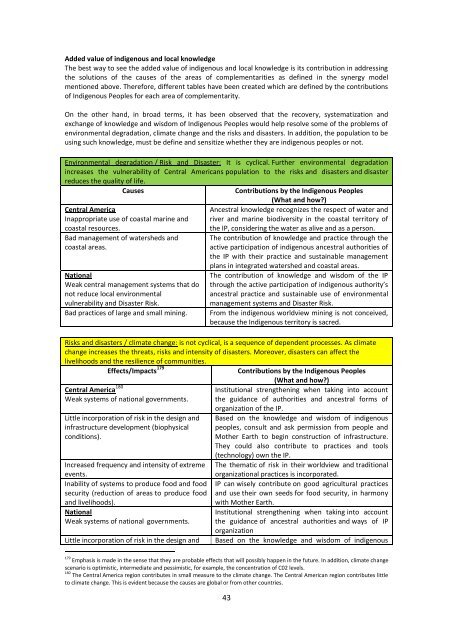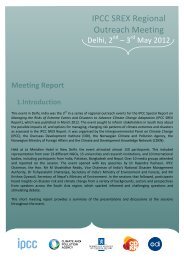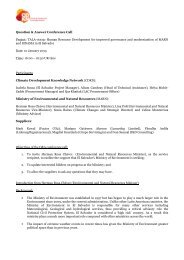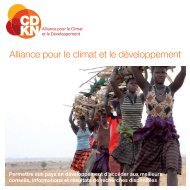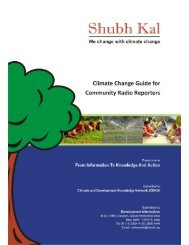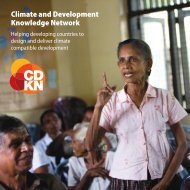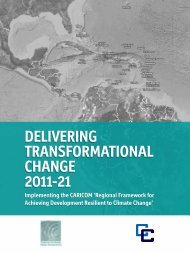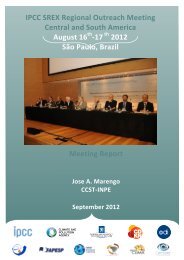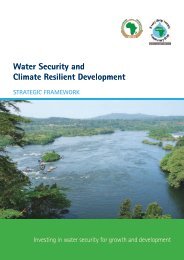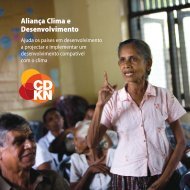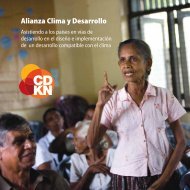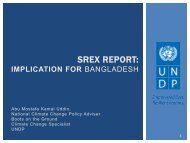Harmonized Perspectives - CDKN Global
Harmonized Perspectives - CDKN Global
Harmonized Perspectives - CDKN Global
- No tags were found...
Create successful ePaper yourself
Turn your PDF publications into a flip-book with our unique Google optimized e-Paper software.
Added value of indigenous and local knowledgeThe best way to see the added value of indigenous and local knowledge is its contribution in addressingthe solutions of the causes of the areas of complementarities as defined in the synergy modelmentioned above. Therefore, different tables have been created which are defined by the contributionsof Indigenous Peoples for each area of complementarity.On the other hand, in broad terms, it has been observed that the recovery, systematization andexchange of knowledge and wisdom of Indigenous Peoples would help resolve some of the problems ofenvironmental degradation, climate change and the risks and disasters. In addition, the population to beusing such knowledge, must be define and sensitize whether they are indigenous peoples or not.Environmental degradation / Risk and Disaster: It is cyclical. Further environmental degradationincreases the vulnerability of Central Americans population to the risks and disasters and disasterreduces the quality of life.CausesContributions by the Indigenous Peoples(What and how?)Central AmericaInappropriate use of coastal marine andcoastal resources.Bad management of watersheds andcoastal areas.NationalWeak central management systems that donot reduce local environmentalvulnerability and Disaster Risk.Bad practices of large and small mining.Ancestral knowledge recognizes the respect of water andriver and marine biodiversity in the coastal territory ofthe IP, considering the water as alive and as a person.The contribution of knowledge and practice through theactive participation of indigenous ancestral authorities ofthe IP with their practice and sustainable managementplans in integrated watershed and coastal areas.The contribution of knowledge and wisdom of the IPthrough the active participation of indigenous authority’sancestral practice and sustainable use of environmentalmanagement systems and Disaster Risk.From the indigenous worldview mining is not conceived,because the Indigenous territory is sacred.Risks and disasters / climate change: is not cyclical, is a sequence of dependent processes. As climatechange increases the threats, risks and intensity of disasters. Moreover, disasters can affect thelivelihoods and the resilience of communities.Effects/Impacts 179Contributions by the Indigenous PeoplesCentral America 180Weak systems of national governments.Little incorporation of risk in the design andinfrastructure development (biophysicalconditions).Increased frequency and intensity of extremeevents.Inability of systems to produce food and foodsecurity (reduction of areas to produce foodand livelihoods).NationalWeak systems of national governments.Little incorporation of risk in the design and(What and how?)Institutional strengthening when taking into accountthe guidance of authorities and ancestral forms oforganization of the IP.Based on the knowledge and wisdom of indigenouspeoples, consult and ask permission from people andMother Earth to begin construction of infrastructure.They could also contribute to practices and tools(technology) own the IP.The thematic of risk in their worldview and traditionalorganizational practices is incorporated.IP can wisely contribute on good agricultural practicesand use their own seeds for food security, in harmonywith Mother Earth.Institutional strengthening when taking into accountthe guidance of ancestral authorities and ways of IPorganizationBased on the knowledge and wisdom of indigenous179 Emphasis is made in the sense that they are probable effects that will possibly happen in the future. In addition, climate changescenario is optimistic, intermediate and pessimistic, for example, the concentration of C02 levels.180 The Central America region contributes in small measure to the climate change. The Central American region contributes littleto climate change. This is evident because the causes are global or from other countries.43


